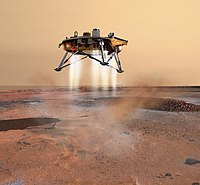Canada contributes weather station to NASA Mars mission
Saturday, April 14, 2007

Credit: Corby Waste (JPL/NASA)
Canada has contributed a significant component to NASA's Phoenix mission to Mars, announced Maxime Bernier, Canada's Minister of Industry. In a news release on Thursday, Bernier, who is also responsible for the Canadian Space Agency (CSA), indicated that Canada had provided a meteorological station, named MET.
The Phoenix Lander, with several on-board instruments, is to launch in August 2007 and touch down on Mars in May 2008. It will gather information on the Martian climate and weather, and will search for habitable zones.
The MET is to play a significant role in NASA's mission by providing information on the Mars atmosphere. The MET is comprised of a pressure sensor, three temperature sensors located on a mast, and a lidar. A lidar is similar to radar but employs laser light rather than microwaves.
The MET instruments were designed by Canadian scientists and private industry, which had received CA$37 million in funding from the CSA. "Our contribution to the Phoenix mission will inspire young Canadians to take their place as part of the next space generation," said Bernier.
Canada has provided astronauts and technology to international space programs. Examples of technological contributions include the Canadarm and Canadarm2 on the Space Shuttle and International Space Station.
With the experience gained from the Phoenix mission, NASA hopes to provide a foundation for future robotic missions and, one day, human exploration of Mars.
Related news
- "Massive ice deposits found on Mars" — Wikinews, March 17, 2007
- "Reconnaissance Orbiter finds more evidence of water on the planet Mars" — Wikinews, February 17, 2007
- "NASA: Signs of liquid water found on surface of Mars" — Wikinews, December 7, 2006
External links
Sources
- News Release. "Canada Contributes a Weather Station to the Phoenix Mission to Mars" — Canadian Space Agency, April 12, 2007
- "Canada delivers weather station for NASA mission" — CTV News, April 12, 2007


